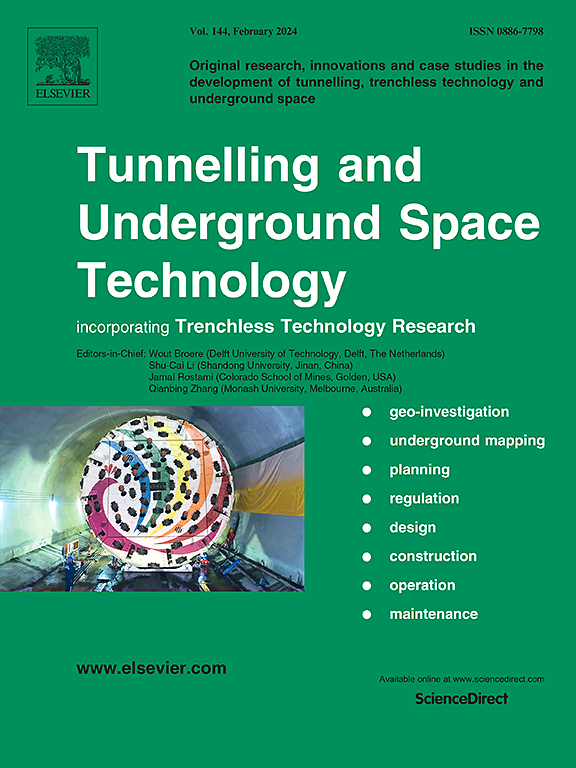衬砌密度对盾构隧道地震响应的影响:振动台试验与简化半解析解
IF 7.4
1区 工程技术
Q1 CONSTRUCTION & BUILDING TECHNOLOGY
引用次数: 0
摘要
钻地盾构隧道(GPST)方法通过消除深竖井、缩短施工时间和最大限度地减少对环境的影响,优化了软土地基的施工。本文研究了衬砌密度对隧道地震反应的影响。进行了大型振动台试验,比较了不同衬砌密度下两种隧道模型的响应。这两个隧道模型的分段衬砌采用了两种不同的石膏混合料,第一种是正常重量骨料,代表普通衬砌,第二种是轻质骨料,代表密度降低50%的轻质衬砌。利用详细的仪器系统,实验结果揭示了两种隧道模型地震反应的关键差异,量化了衬砌密度的影响。所得的见解用于开发和验证简化的半分析模型,该模型随后用于参数分析。该模型基于基于温克勒基础的梁法,考虑了土体模量随深度的变化。参数分析表明,隧道地上段的动力响应与衬砌密度有较强的相关性。衬砌密度的减小导致地上隧道部分的惯性响应减小,其结构位移显著减小。衬砌密度对隧道的频率响应也有显著影响,衬砌密度的减小导致隧道的固有频率偏离土体的主频率,从而进一步降低隧道的惯性响应。本文章由计算机程序翻译,如有差异,请以英文原文为准。
The effect of lining density on the seismic response of ground penetrating shield tunnels: Shaking table testing and simplified semi-analytical solution
The Ground Penetrating Shield Tunnel (GPST) method optimizes construction in soft ground by eliminating deep vertical shafts, reducing construction time, and minimizing the environmental impact. The present study examines the effect of lining density on the seismic response of the tunnel. Large scale shaking table tests are conducted, comparing the response of two tunnel models with different lining densities. The segmental lining of the two tunnel models is constructed employing two different gypsum mixes, the first one with normal weight aggregates representing an ordinary lining, and the second one with lightweight aggregates representing a lightweight lining of 50% reduced density. Employing a detailed instrumentation system, the experimental results reveal the key differences in the seismic response of the two tunnel models, quantifying the effect of lining density. The derived insights are used to develop and validate a simplified semi-analytical model, which is subsequently employed for parametric analyses. The model is based on a beam resting on Winkler foundation approach, accounting for the variation of soil modulus with depth. The parametric analyses reveal a strong correlation between the dynamic response of the above-ground portion of the tunnel and lining density. The decrease of lining density leads to a decrease of the inertial response of the above-ground tunnel portion, and to a substantial decrease of its structural displacement. The lining density also has a significant effect on the frequency response of the tunnel, with its reduction leading to a shift of the tunnel’s natural frequency away from the predominant frequency of the soil, further reducing the inertial response of the tunnel.
求助全文
通过发布文献求助,成功后即可免费获取论文全文。
去求助
来源期刊

Tunnelling and Underground Space Technology
工程技术-工程:土木
CiteScore
11.90
自引率
18.80%
发文量
454
审稿时长
10.8 months
期刊介绍:
Tunnelling and Underground Space Technology is an international journal which publishes authoritative articles encompassing the development of innovative uses of underground space and the results of high quality research into improved, more cost-effective techniques for the planning, geo-investigation, design, construction, operation and maintenance of underground and earth-sheltered structures. The journal provides an effective vehicle for the improved worldwide exchange of information on developments in underground technology - and the experience gained from its use - and is strongly committed to publishing papers on the interdisciplinary aspects of creating, planning, and regulating underground space.
 求助内容:
求助内容: 应助结果提醒方式:
应助结果提醒方式:


